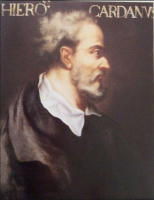










Gerolamo Cardano was an Italian Renaissance mathematician, physician, astrologer, philosopher and gambler.He wrote more than 200 works on medicine, mathematics, physics, philosophy, religion, and music.His gambling led him to formulate elementary rules in probability, making him one of the founders of the field.
Early life and education
He was born in Pavia, Lombardy, the illegitimate child of Fazio Cardano, a mathematically gifted lawyer, who was a friend of Leonardo da Vinci. In his autobiography, Cardano claimed that his mother had attempted to abort him. Shortly before his birth, his mother had to move from Milan to Pavia to escape the Plague; her three other children died from the disease.
In 1520, he entered the University of Pavia and later in Padua studied medicine. His eccentric and confrontational style did not earn him many friends and he had a difficult time finding work after his studies had ended. In 1525, Cardano repeatedly applied to the College of Physicians in Milan, but was not admitted owing to his combative reputation and illegitimate birth.
Eventually, he managed to develop a considerable reputation as a physician and his services were highly valued at the courts. He was the first to describe typhoid fever. In 1553 he cured the Scottish Archbishop of St Andrews of a disease that had left him speechless and was thought incurable. The diplomat Thomas Randolph recorded the "merry tales" rumoured about his methods still current in Edinburgh nine years later. Cardano himself wrote that the Archbishop had been short of breath for ten years, and after the cure was effected by his assistant, he was paid 1,400 gold crowns.
Mathematics
Today, he is best known for his achievements in algebra. Cardano was the first mathematician to make systematic use of numbers less than zero.He published the solutions to the cubic and quartic equations in his 1545 book Ars Magna. The solution to one particular case of the cubic equation ax^3+bx+c=0(in modern notation), was communicated to him by Niccolò Fontana Tartaglia (who later claimed that Cardano had sworn not to reveal it, and engaged Cardano in a decade-long fight) in the form of a poem.The quartic was solved by Cardano's student Lodovico Ferrari. Both were acknowledged in the foreword of the book, as well as in several places within its body. In his exposition, he acknowledged the existence of what are now called imaginary numbers, although he did not understand their properties (described for the first time by his Italian contemporary Rafael Bombelli, although the necessary mathematical theory of fields was not to be developed for hundreds of years).In Opus novum de proportionibus he introduced the binomial coefficients and the binomial theorem.
Cardano was notoriously short of money and kept himself solvent by being an accomplished gambler and chess player. His book about games of chance, Liber de ludo aleae ("Book on Games of Chance"), written around 1564,but not published until 1663, contains the first systematic treatment of probability,as well as a section on effective cheating methods. He used the game of throwing dice to understand the basic concepts of probability. He demonstrated the efficacy of defining odds as the ratio of favourable to unfavourable outcomes (which implies that the probability of an event is given by the ratio of favourable outcomes to the total number of possible outcomes). He was also aware of the multiplication rule for independent events but was not certain about what values should be multiplied.Cardano invented several mechanical devices including the combination lock, the gimbal consisting of three concentric rings allowing a supported compass or gyroscope to rotate freely, and the Cardan shaft with universal joints, which allows the transmission of rotary motion at various angles and is used in vehicles to this day. He studied hypocycloids, published in de proportionibus 1570. The generating circles of these hypocycloids were later named Cardano circles or cardanic circles and were used for the construction of the first high-speed printing presses.
He made several contributions to hydrodynamics and held that perpetual motion is impossible, except in celestial bodies. He published two encyclopedias of natural science which contain a wide variety of inventions, facts, and occult superstitions. He also introduced the Cardan grille, a cryptographic tool, in 1550.
Someone also assigned to Cardano the credit for the invention of the so-called Cardano's Rings, also called Chinese Rings, but it is very probable that they predate Cardano.
Significantly, in the history of education of the deaf, he said that deaf people were capable of using their minds, argued for the importance of teaching them, and was one of the first to state that deaf people could learn to read and write without learning how to speak first. He was familiar with a report by Rudolph Agricola about a deaf mute who had learned to write.
Later years
Cardano's eldest and favorite son was executed in 1560 after he confessed to having poisoned his cuckolding wife. His other son was a gambler, who stole money from him. He allegedly cropped the ears of one of his sons. Cardano himself was accused of heresy in 1570 because he had computed and published the horoscope of Jesus in 1554. Despite numerous stories to the contrary, it is not true that his own son contributed to the prosecution after being bribed by Tartaglia, as Tartagalia died 13 years previously.He was arrested, had to spend several months in prison and was forced to abjure his professorship. He moved to Rome, received a lifetime annuity from Pope Gregory XIII (after first having been rejected by Pope Pius V) and finished his autobiography. It appears that he was still practicing medicine up to his death in 1576.The date of his death is disputed, but a death year is given as 1576.